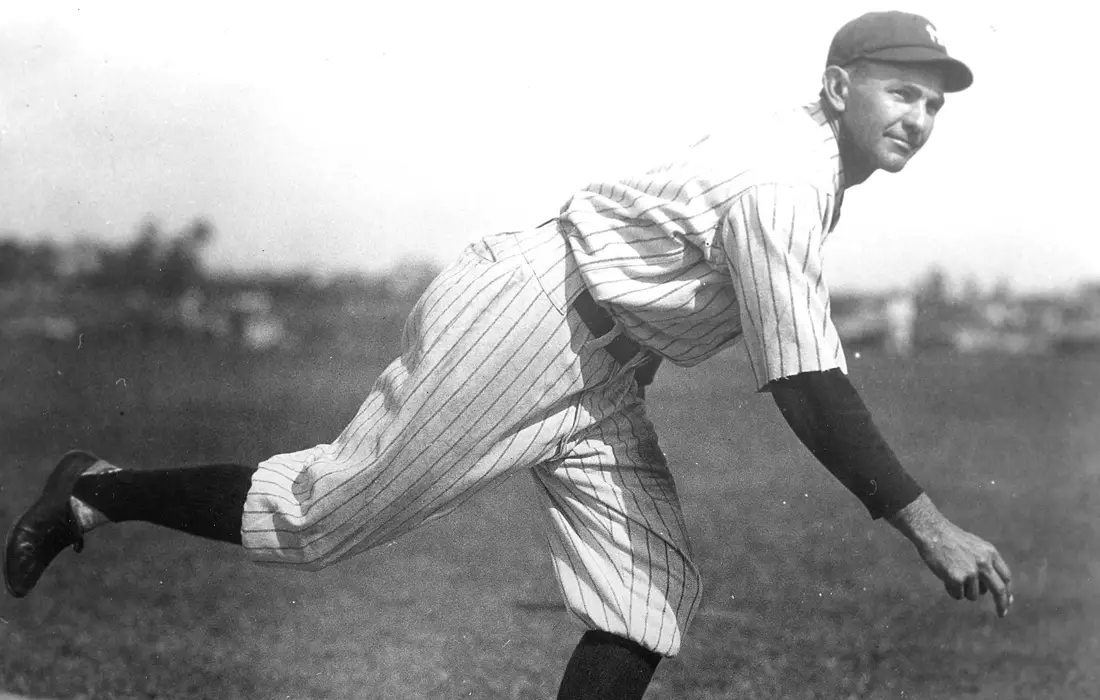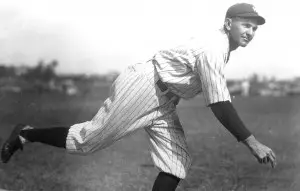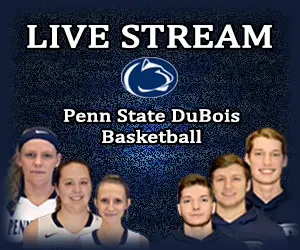

Bob Shawkey of Sigel was the New York Yankees starting pitcher in the first game ever played at the original Yankee Stadium.
Note: This story originally ran on D9sports.Com last spring, but it’s worth looking at again, in celebration of another start to a Major League Baseball season. Updates are included, of course.
By Rich Rhoades
With the Major League Baseball season getting into full swing, one (well at least I do) must beg a District 9 question:
Who are the best Major Leaguers from D9 ever?
With the help of the greatest sports web site in existence www.baseball-reference.com, I dove into answering this question with an in-depth look at players who were born in the current District 9 geographical area. Based on birthplaces, this is how I came up with the list. Most likely, some of the players on the list below — every District 9 native is below — may not have spent much time where they were born (see Doug Brocail) and what might be missing are players who weren’t born in D9 but moved into the area. It’s doubtful that many have done that, but we’ll see if I missed someone.
After compiling the all-time list, the drafting of the all-time team obviously became easier. I went with starters and a six-man rotation. I even picked a manager, Punxsutawney’s own John “Sarge” Mizerock. He managed in 1,200 minor league games and spent plenty of time in the majors as coach, so that’s definitely good enough for me.
He’ll have a player/coach to work with in shortstop Billy Hunter, another Punxsutawney-born player who was a promising infield prospect that went on to put together a solid coaching career as Earl Weaver’s third-base coach with the Baltimore Orioles. Hunter is the shortstop — that’s where he played the most — while Roulette’s Don Hoak, a vital cog in the Pittsburgh Pirates’ run to the 1960 World Series title, is the third baseman.
That’s a pretty good start. But you have to have pitching and that’s one thing this squad has, starting with a Hall of Famer in turn-of-the century left-handed ace Rube Waddell, who was born in Bradford. He was nuts (clinically, you could say), but he couldn’t be characterized as the only character on this roster for sure. D9’s all-time closer is Sparky Lyle of Reynoldsville was an original as well. Lyle helped usher in the closer era back in the 1970s, although he was far more than a three-out specialist. My favorite: The Yankees played “Pomp and Circumstance” when he entered the game. Perfect.
Joining Lyle in the bullpen is another lefty in Joe Beimel, the Kersey native who was recently signed to a minor league contract by the team he pitched for last year, the Seattle Mariners. Beimel is another original, and his 623 appearances get him on the team for sure. Beimel, who turns 38 April 19, was born the year Lyle won his American League Cy Young Award.
A late addition to the bullpen is Cherry Valley’s Joe Page. Cherry Valley was a sneaky last-second find. It’s located not far from Emlenton and it’s believed to be in the Moniteau School District. With that discovery, Page is a no-brainer as powerful left-handed addition to Lyle and Beimel. Page set the MLB saves record in 1949 with the World Series champion New York Yankees and it wasn’t broken until 1961. He pitched on three All-Star teams.
Speaking of Cy Young, Ridgway native Billy Rhines would’ve won a Cy Young Award in the National League as a rookie way back in 1890 if they had that award — Cy Young was also a rookie the same year — when he went 28-17 with a 1.95 ERA in a whopping 401 innings. Sure, different era, different expectations from pitchers back then, but if you can go 401 innings in a season, you’re my long man on this team.
Two other starting pitchers made the staff, giving this team quite a bit of talent on the mound. Sigel’s Bob Shawkey won nearly 200 games in a career that started with the Philadelphia Athletics when they were powerful in the mid-teen years and finished with the mighty Yankees of the 1920s. He also was the starting pitcher in the first game ever played at Yankee Stadium in 1923.
The other starter is Mal Eason. While he didn’t put together an especially notable career as a pitcher, he did throw a no-hitter in 1906 and then went on to umpire nearly a decade after his career was over. Those resume fillers make him a must-have on any team.
Admittedly, the non-pitching lineup has a few holes with the depth of talent over the history of the game being rather thin from West-Central Pennsylvania. However, there are a handful of legitimate Big Leaguers in this lineup.
We’ll start with backstop Ossee Schrecongost of New Bethlehem. He’s an absolute crucial element to the success of this dream team considering he was a teammate and close friend at one point with Waddell for six seasons on the Philadelphia Athletics during Waddell’s best years in the first decade of the 1900s.
I know, I know, Punxsutawney’s Devin Mesoraco had a breakout year last season and made the All-Star team, but give me a little bit more and he’s my man, without a doubt. Schrecongost caught
At first base, Coder’s Rube Bressler — Coder located between Brookville and Summerville — gets the nod. He started his career with the Athletics about the same time as Shawkey as a pitcher, but wound up being a quality utility player whose career batting average was .301 over a 19-year career.
Claude Ritchey of Emlenton is the second baseman. He played for the Pittsburgh Pirates alongside shortstop Honus Wagner during the first decade of the 1900s.
Roulette’s Hoak upgrades this lineup significantly, considering his fiery brand of style and championship caliber of play that helped two teams reach the World Series, including the Pittsburgh Pirates in 1961. He hit .265 and provided solid glove work at the hot corner in his 11-year career.
The outfield was pretty good, actually, starting with speedy Jimmy Slagle of the last Chicago Cubs team that won a World Series way back in 1907. Punxsutawney’s Wilbur Good and Shinglehouse’s Fielder Jones, all of them early-1900s players, join the Worthville native.
Added to the lineup is another bat that adds some pop to the offense, thus creating the need to hit for the pitcher with a designated hitter. Clarendon’s Sherry Magee played 15 years from 1904-1919 and had over 2,100 career hits mostly with the Philadelphia Phillies. Magee nearly won the NL triple crown in 1910 and he finished with a .291 career batting average.
One clubhouse hurdle that could need to be addressed by Mizerock and his staff — Eason ejected Good from a game.
Take a closer look below at the MLB D9 alumni list:
All-Time District 9 MLB Dream Team
C Ossee Schrecongost, New Bethlehem
1B Rube Bressler, Coder
2B Claude Ritchey, Emlenton
SS Billy Hunter, Punxsutawney Player/Coach
3B Don Hoak, Roulette
OF Wilbur Good, Punxsutawney
OF Fielder Jones, Shinglehouse
OF Jimmy Slagle, Worthville
OF/DH Sherry Magee, Clarendon
Starting Pitcher: Rube Waddell, Bradford
Starting Pitcher: Bob Shawkey, Sigel
Starting Pitcher: Mal Eason, Brookville
Long man: Billy Rhines, Ridgway
Reliever: Sparky Lyle, Reynoldsville
Reliever: Joe Page, Cherry Valley
Reliever: Joe Beimel, Kersey
Manager: John Mizerock, Punxsutawney
HITTERS
Al Bradley, Brady’s Bend (1884)
This one goes way back. He was an outfielder who appeared in one game as a 28-year-old for the Washington Nationals in the Union Association. He went 0-for-3 with two walks in his only professional game.
Rube Bressler, Summerville/Coder
He put together a remarkable 19-year career, starting as a promising rookie pitcher for Connie Mack’s Philadelphia Athletics in 1914 and ending as a .300-hitting first baseman/outfielder with the Cincinnati Reds and Brooklyn Robins. He went 10-4 with a 1.77 ERA as a 19-year-old rookie with the A’s who were swept in the 1914 World Series by the Boston Braves. He then went 4-17 in 1915 when the A’s dropped to 109 losses after winning 96 in 1914. With his pitching career pretty much over with a dead arm, Bressler switched to a position player. He moved on to the Cincinnati Reds from 1917 through 1927, playing mostly as a backup utilityman. In 1924, he hit .347 in 415 plate appearances, and then followed with .348 and .357 seasons off the bench before hitting .291 with 77 RBIs as a regular outfielder in 1927. He moved on to Brooklyn in 1928-1931 and hit .302 with the then-called Robins.
Marc Campbell, Punxsutawney (1907)
He played in two games for the Pittsburgh Pirates in 1907 as a shortstop, going 1-for-4 with a walk. While he was born in Punxsutawney, he died and was buried in New Bethlehem.
He played one season for the St. Louis Browns in 1912 as a 25-year-old shortstop. He batted .173 in 18 games.
He played in four seasons, 1908 with the Cincinnati Reds, 1913-14 with the Philadelphia Athletics and 1914-15 with the New York Yankees, compiling a .239 batting average in 183 games overall as an outfielder. He played in over 1,600 minor league games from 1906 through 1918.
Jim Duffalo, Helvetia (1961-1965)
The Clearfield County native was a right-handed relief pitcher in the 1960s for the San Francisco Giants in four of the five seasons he threw in the bigs. Duffalo made his MLB debut against the team that signed him in 1955, the Pittsburgh Pirates. In 141 appearances, he was 15-8 with a 3.39 ERA. Duffalo was a member of the 1962 NL Champion Giants, although he didn’t appear in their World Series loss to the New York Yankees. He appeared in 387 games in the minors that covered his first year as a 19-year-old in 1955 until his final season as a 36-year-old in 1972.
Wilbur Good, Punxsutawney (1905-1918)
His career spanned 11 seasons as an outfielder for the New York Highlanders, Cleveland Naps, Boston Rustlers, Chicago Cubs and Philadelphia Phillies. His only two seasons as a full-time player were 1914-15 with the Cubs where in 1914 he hit .272 with 31 stolen bases. He was a lifetime .258 hitter in 2,651 career at-bats
Nick Goulish, Punxsutawney (1944-1945)
He played in 14 games as an outfielder in two seasons during World War II with the Philadelphia Phillies. He was 3-for-12. He played six seasons in the minors from 1938 through 1946.
Emmet Heidrick, Queenstown (1898-1908)
Queenstown is his listed birth place, which isn’t far from East Brady. He was another player from the early 1900s, an outfielder for eight seasons mostly for the St. Louis Browns and Cardinals. He was a .300 career hitter in 757 games with 186 stolen bases. He’s buried in Clarion.
Don Hoak, Roulette (1954-1964)
A native of Roulette (near Port Allegany), Hoak was the starting third baseman for two World Series championship teams in Brooklyn (1955) and Pittsburgh (1960). He played four years with the Pirates from 1959 through 1962 and had the best years of his 11-year career, hitting .281. Overall, he was a .265 career hitter who broke in with the Dodgers where he played two years before going to the Chicago Cubs in 1956 and then the Cincinnati Reds in 1957-58. Perhaps his best overall season came in 1957 with the Reds where he was named to the National League All-Star team, hitting .293 with 39 doubles, 19 home runs and 89 RBIs. Hoak was the NL MVP runner-up to Pirates teammate Dick Groat in 1960 when he hit .282 with 16 home runs and 79 RBIs.
Billy Hunter, Punxsutawney (1953-1958)
Hit .219 in six seasons as a backup infielder for the St. Louis Browns, Baltimore Orioles, New York Yankees, Kansas City A’s and Cleveland Indians. Hunter was a highly regarded prospect prior to his MLB debut with the Browns in 1953. That year, Hunter actually made the all-star team and represented the Browns with Hall of Famer Satchel Paige and pinch-ran for Mickey Mantle. One year later, Hunter was involved in a whopping 17-player trade in 1954 between the Orioles and Yankees that brought him, Don Larsen (he of the 1956 World Series perfect game) and Bob Turley to the Yankees.
But his most significant career highlight was a 13 ½-year stint with the Orioles mostly as Hall of Fame manager Earl Weaver’s third-base coach. The Orioles won two World Series titles with him coaching in 1966 and 1970. Hall of Fame outfielder Frank Robinson credited Hunter with creating the “Kangaroo Court,” a club house function that served to loosen up the team and point out mistakes at the same time, something that’s been adopted by many teams over the years. Hunter managed the Texas Rangers in 1977-78.
Here’s his great bio on the SABR Baseball Biography Project
Alex Jones, Bradford (1889-1903)
He was a turn-of-the-century pitcher for the five different teams in four seasons, including the Pittsburgh Alleghenys in 1889. He was 7-15 with a 3.73 ERA in 26 appearances.
In a 15-year career that began in 1896, he was an everyday outfielder for the Brooklyn Superbas and Chicago White Sox before closing out his career with a handful of games in the Federal League with the St. Louis Terriers in 1914-15. He was a .285 lifetime hitter with 1,920 career hits. He was a starter on the 1906 World Series champion White Sox.
Jones managed for 10 seasons, all but three of them as a player/manager. In 1906, he directed the White Sox to a World Series title.
Here’s his complete bio on the SABR Baseball Biography Project
Milt Jordan, Mineral Springs (1953)
The Clearfield High School graduate appeared in eight games as a right-handed pitcher for the Detroit Tigers in 1953, compiling an 0-1 record with a 5.82 ERA in 17 innings.
Sherry Magee, Clarendon (1904-1919)
He was a Warren County native and resident of Clarendon (near Sheffield) who appeared in over 2,000 career games mostly as an outfielder during a 16-year-career that produced over 2,100 career hits and a lifetime batting average of .291. The first 11 seasons were spent with the Philadelphia Phillies where he won the National League batting crown in 1910, hitting .331. He also led the NL that year in RBIs (123), runs (110) and slugging percentage (.507). In 1914, he led the NL in hits (171), doubles (39), RBIs (103) and slugging percentage (.509)
Devin Mesoraco, Punxsutawney (2011-present)
Mesoraco’s breakout season last year included an All-Star berth, which was well-deserved after he hit 25 home runs with 80 RBIs in 114 games with the Cincinnati Reds. In the offseason, he landed a four-year, $28 million contract. He was the 15th pick of the first round of the 2007 Amateur Draft as he was leading the Punxsutawney Chucks to a state title. Mesoraco reached the bigs by 2011 and has appeared in 289 MLB games to date.
John “Sarge” Mizerock, Punxsutawney (1983-1989)
One of the standout multi-sport athletes of the late 1970s in District 9, Mizerock, catcher, was a first-round selection of the Houston Astros in 1979. He was the eighth pick of the opening round that also included future NFL quarterback Jay Schroeder (Blue Jays, 3rd, pick) Andy Van Slyke (Cardinals, 6th pick) and Tim Wallach (Expos, 10th pick)
He wound up appearing in 103 games with the Astros and Atlanta Braves before embarking on an extensive coaching career that saw him manage 1,200 games at various levels. He was in the Kansas City Royals organization for several years and now he’s an assistant batting coach for the Philadelphia Phillies. He was an interim manager for the Royals in 2002 for 13 games.
He played 10 games and hit .189 as a third baseman/outfielder the Cleveland Naps in 1909. His minor-league career spanned seven seasons with several teams from 1908 through 1914, at least 741 games.
Joe Page (1944-1954), Cherry Valley (near Emlenton)
He pitched eight years, mostly for the New York Yankees from 1944-50 where he was the team’s top reliever for a three-year stretch that saw him lead the American League in saves in 1947 and 1949. In those two years, he appeared in the World Series, helping the Yankees win both titles. He was named to three All-Star games in 1944, 1947 and 1948. In 285 appearances, all but seven with the Yankees, Page was 57-49 with a 3.53 ERA and 76 saves back in an era where that statistic was not considered as big as it is today. His 27 saves in 1949 set a MLB single-season record that wasn’t eclipsed until 1961.
He played in 12 games as a second baseman/outfielder for the Chicago Orphans, batting .176.
Claude Ritchey, Emlenton (1897-1909)
He played over 1,600 games mostly as a second baseman in 13 seasons with the Cincinnati Reds, Louisville Colonels, Pittsburgh Pirates and Boston Braves from 1897 through 1909. He was the starting second baseman for the Pirates who lost in the 1903 World Series to Boston. He batted .273 with 1,619 hits.
Here’s his bio on the SABR Baseball Biography Project
Ossee Schrecongost, New Bethlehem (1897-1908)
He was a catcher for most of 11 seasons, most of it with the Philadelphia Athletics from 1902 through 1908. He was a .271 career hitter. He was known as a strong defensive catcher during the dead-ball era, throwing out over 40 percent of runners stealing. He was the starting catcher for the 1905 Athletics who lost in the World Series to the New York Giants.
Frank Shugart, Luthersburg (1890-1901)
He played mostly as a shortstop in the 1890s for the Pittsburgh Pirates and St. Louis Cardinals. He hit .267 in 745 games spanning eight seasons.
Jimmy Slagle, Worthville (1899-1908)
He played in 1,300 games as a speedy outfielder from 1899-1908 mostly with the powerful Chicago Cubs of that era. Slagle was a starter on the 1907 World Series Champion Cubs. He finished with a .268 career batting average with 274 stolen bases. He was the first player to successfully accomplish a straight steal of home in the 1907 World Series.
This story on Slagle ran in the New York Times in 2007. By the way, Worthville is in the Punxsutawney school district, just on the northern edge of the district bordering Brookville.
He appeared in one game for the Detroit Tigers in 1912 as an 18-year-old as a third baseman. He didn’t have a plate appearance.
He appeared in five games for the Chicago White Sox in 1927, going 1-for-3. He was a second baseman and pinch-runner.
PITCHERS
Willie Adams, Clearfield (1912-19)
5 seasons … 8-16 in 65 games for St. Louis Browns and Philadelphia Athletics with a 1-year stint in the Federal League in 1914 with the Pittsburgh Rebels
Appeared in 1 game for the New York Highlanders as a 28-year-old. Won in relief, 7 innings, 1 run with just four hits and 3 strikeouts.
Joe Beimel, Kersey (2001-present)
He was an 18th-round pick of the Pittsburgh Pirates out of Duquesne University in 1998. He made the bigs in 2001 first as a starting pitcher but eventually wound up in the bullpen, appearing in 69 games for the Pirates in his third season in 2003. Beimel then was released and saw brief times in the bigs with the Minnesota Twins and Tampa Bay Rays in 2004-05. It was in the Rays system at Class AAA Durham where Beimel refined his mechanics and turned his career around. From 2006 through 2008, he was one of the majors’ most reliable left-handed relievers, appearing in 216 games with a 3.04 ERA. He landed in Washington in 2009 and was traded in a deadline deal to the Colorado Rockies in 2009. He threw for the Rockies in 2010 before returning to his original team in Pittsburgh in 2011. He was released after 35 games and in 2012 had Tommy John surgery. Last year, in his first MLB action since that 2011 season, he sported a 2.20 ERA in 56 outings out of the Seattle Mariners bullpen.
He was born in Clearfield but grew up in Colorado. His minor-league career spanned parts of 16 seasons from 1986 when he was a first-round pick of the San Diego Padres through 2009 and he appeared in 626 games in the majors with the Padres, Houston Astros, Detroit Tigers and Texas Rangers, mostly as a reliever. He’s currently serving in the front office of the Astros.
Mark Corey, Coudersport (2001-2004)
He was born in Coudersport, but graduated from Austin High School. His MLB career spanned four years from 2001 through 2004, starting with the New York Mets with one year on the Colorado Rockies before his final two seasons with the Pirates in 2003-04. He was 2-7 in 81 appearances, all of them in relief. He appeared in 416 games in the minors in parts of 12 seasons, the last being with the Pirates’ Class AAA affiliate Indianapolis in 2007.
Mal Eason, Brookville (1900-1906)
Threw a no-hitter in 1906 while pitching for the Brooklyn Superbas against the St. Louis Browns in his last season in the bigs. He walked five and struck out three in the Superbas’ 2-0 win over the Browns on July 20. He was 10-17 that year and finished 36-73 in 125 games for the Chicago Cubs, Boston Braves, Detroit Tigers and Brooklyn.
Eason was a full-time National League umpire from 1911 through 1916 and called 992 career games. According to retrosheet.org, Eason ejected 89 players or managers during a time when that wasn’t a whole lot surprising. Among them were Hall of Fame managers John McGraw (7 times), Miller Huggins, Bill McKechnie, Wilbert Robinson and Clark Griffith, not to mention Hall of Fame players Johnny Evers, Mordecai “Three Finger” Brown and Casey Stengel, when Stengel was a player long before his famous run as Yankees manager. Eason even threw out Punxsutawney’s own Wilbur Good for arguing balls and strikes during a game in June of 1914.
Josh Kinney, Port Allegany (2006-2014)
He was in the Pittsburgh Pirates system in Class AAA Indianapolis last year and went 2-3 with a 3.38 ERA in 47 relief outings. His career started with him signing as a free agent with the St. Louis Cardinals, starting in the minors in 2001. By 2006, he made the Cardinals and appeared in 21 games for the eventual World Series champions. He appeared in seven postseason games, notching a win in relief in the NLCS against the New York Mets. From there, an elbow injury kept him out of the majors in 2007 and he eventually returned to pitch in 24 combined for the Cardinals in 2008-09. He appeared in 13 games with the White Sox in 2011 and 35 for the Seattle Mariners in 2012 before pitching in 30 games for the Mariners’ Class AAA affiliate Tacoma in 2013.
Ed Klepfer, Summerville (1911-1919)
Compiled a 22-17 record in 98 games pitching for the New York Highlanders, Chicago White Sox and Cleveland Indians. He was 14-4 and led the AL in winning percentage in 1917. In 213 innings, he didn’t give up a single home run.
Pitched one season as a 20-year-old for Connie Mack’s Philadelphia Athletics in 1915. He went 4-6 in 18 games covering 100 2/3 innings.
Sparky Lyle, Reynoldsville (1967-1982)
The Reynoldsville native was one of the dominating relievers of the 1970s and won the 1977 American League Cy Young Award in helping the New York Yankees to their first World Series title in 15 years. That year, he was 13-5 with a 2.17 ERA and 26 saves. He appeared in 72 games that covered 137 innings. For his career, Lyle finished with 238 saves and briefly was the all-time leader in that category before being surpassed by Rollie Fingers and then many others as the specialty closer era locked in one pretty much a one-inning only appearance. Lyle regularly worked beyond a three-out save scenario. His 899 appearances at the end of his career was No. 1 on the all-time list. He’s now 25th all-time. These days, Lyle is part-owner and manager of the Somerset (N.Y.) Patriots of the Independent Atlantic League, a team he’s managed since 1998.
Here’s his bio on SABR Baseball Biology Project
Joe Page (1944-1954), Cherry Valley (near Emlenton)
He pitched eight years, mostly for the New York Yankees from 1944-50 where he was the team’s top reliever for a three-year stretch that saw him lead the American League in saves in 1947 and 1949. In those two years, he appeared in the World Series, helping the Yankees win both titles. He was named to three All-Star games in 1944, 1947 and 1948. In 285 appearances, all but seven with the Yankees, Page was 57-49 with a 3.53 ERA and 76 saves back in an era where that statistic was not considered as big as it is today. His 27 saves in 1949 set a MLB single-season record that wasn’t eclipsed until 1961.
The former standout Beaver helped lead his high school team to a state championship game berth in 1992. He was selected by the Kansas City Royals with the 17th pick of the first round in the 1992 Amateur Draft and made his MLB debut three years later. An arm injury knocked him almost entirely out of the 1996 season and he returned to the majors in 1997 and pitched for the Royals through 1999. He appeared in 15 games with the Milwaukee Brewers in 1999, his last season. He was 7-12 in 81 appearances covering 225 innings.
Billy Rhines, Ridgway (1890-1899)
Compiled a 113-103 career record in nine seasons with the Cincinnati Reds, Louisville Colonels and Pittsburgh Pirates. He went 28-17 for the Reds and led the National League with a 1.95 ERA in 401 innings in 1890 and led the NL in ERA again in 1896 with the Reds. He also won 20 games in 1897 when he finished 21-15 for the Reds in 1897. He completed his career with the Pirates in 1898-99.
Bob Shawkey, Sigel (1913-1927)
He was a four-time 20-game winner in a 15-year career that started with the powerful Philadelphia Athletics of the 19-teens and ended as a 36-year-old reliever on what many consider the greatest team ever in the 1927 Yankees. Shawkey won 195 games and his 168 with the Yankees rank sixth all-time. He started his career with Connie Mack’s Athletics in 1913 and in 1914 with three other Hall of Fame pitchers on the staff and led the team in innings pitched. On that team was another District 9er in rookie pitcher Rube Bressler of Coder. Shawkey went 15-8 that year as the Athletics were upset in the World Series to the Boston Braves. Shawkey started 1915 with the A’s, but was traded to the Yankees where he finished his career. Shawkey went 24-14 in 1916 and then won 16 or more games in a six-year span from 1919 through 1924, including three 20-win seasons in 1919, 1920 and 1922. Shawkey led the American League in ERA (2.45) in 1920. In 1923, Shawkey was the season-opening pitcher for the Yankees in their brand-new Yankee Stadium. In 1976 when Yankee Stadium re-opened after an extensive renovation, Shawkey threw out the ceremonial first pitch.
Shawkey wound up pitching in four World Series, helping the Yankees win the 1923 title. He didn’t appear in the 1927 World series.
Shawkey managed the Yankees in 1930, replacing Hall of Famer Miller Huggins who died at the end of the previous season. His stint lasted just one season.
Al Verdel, Punxsutawney (1944)
Appeared in one game and pitched one inning, facing three batters, for the Philadelphia Phillies as a 23-year-old rookie. He appeared in 65 games in the minor leagues, his career ending in 1946.
Rube Waddell, Bradford (1897-1910)
Ken Burns’ epic “Baseball” documentary said Waddell was born in Punxsutawney, but he was actually born in Bradford and appeared to have lived there into his teenage years before moving to Butler County. From there, he embarked on zany career that landed him in the Hall of Fame. He was one of the dominant left-handed pitchers of his era, leading the American League in strikeouts for six straight seasons from 1902 through 1907, all of them with the Philadelphia Athletics under Hall of Fame manager Connie Mack. His 349 strikeouts in 1904 was an AL record until Nolan Ryan whiffed 383 batters in 1973. Waddell’s best season came in 1905 with the A’s when he was 27-10 with a 1.48 ERA. In 13 seasons that included stints with the A’s, Pirates, Louisville Colonels, Chicago Cubs and St. Louis Browns, Waddell was 193-143 with a 2.16 ERA. He was inducted into the Hall of fame in 1947.
Here’s Rube’s bio from the SABR Baseball Biography Project.












